Jerome Caja (b. 1958, Cleveland, OH; d. 1995, San Francisco, CA) was an interdisciplinary visual artist and drag performer based in San Francisco from 1985 to 1995. A fixture of the queer underground scene amidst the AIDS crisis, Caja became a renowned persona known for his irreverent style of drag and outrageous performance antics.
Jerome Caja (b. 1958, Cleveland, OH; d. 1995, San Francisco, CA) was an interdisciplinary visual artist and drag performer based in San Francisco from 1985 to 1995. A fixture of the queer underground scene amidst the AIDS crisis, Caja became a renowned persona known for his irreverent style of drag and outrageous performance antics. Simultaneously, his object-based work, which included painting and sculpture, began receiving attention through exhibitions at Bay Area art spaces including Force Nordstrom, Gallery Paule Anglim, Yerba Buena Center for the Arts, and the San Francisco Museum of Modern Art.
Using found objects and everyday materials including nail polish, white-out, and glitter, Caja created often-humorous miniatures that express themes of spirituality, mortality, and sexuality. He used recurring imagery such as Catholic saints, eggs, clowns, and birds, many imbued with the spirit of his midwestern Catholic upbringing.
Caja received a BA from Cleveland State University and an MFA from the San Francisco Art Institute. He died from HIV-related complications in 1995, during the height of the AIDS-Art-Activism era in San Francisco. His work has been featured in exhibitions including Jerome Caja: Ugly Pageant, Bortolami Gallery, New York, NY; For Dear Life: Art, Medicine, and Disability, Museum of Contemporary Art, San Diego, CA; The Body, the Host: HIV/AIDS and Christianity, Allen Memorial Art Museum, Oberlin College, Oberlin, OH; and Art After Stonewall, Grey Art Gallery, New York University, and Leslie-Lohman Museum of Gay and Lesbian Art, New York, NY; Patricia & Philip Frost Art Museum, Miami, FL; and Columbus Museum of Art, Columbus, OH. The artist’s work is also in numerous public collections including SFMoMA, the New York Public Library, and the Los Angeles County Museum. His papers and many small works are part of the Smithsonian's Archives of American Art.

